What to look for at COP29: the cost of delay and the Trump victory
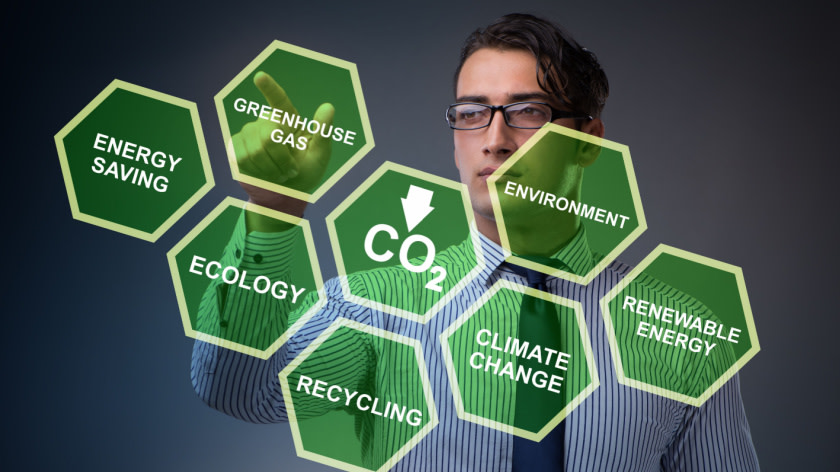
Over the past year, very little progress was made in the ambition and implementation of policies to reduce greenhouse gas emissions globally. At the beginning of next year, countries have to submit their new national commitments to reduce emissions according to the global targets set out in the Paris Agreement (NDCs), with the end-point of the targets extended to 2035, from 2030 . To keep the Paris goals within reach all countries, in particular the G20, have to overperform on their current 2030 climate targets. The new quantifiable goal for climate finance will need to be vastly more ambitious as well as more concrete. The Trump victory in the US could have significant consequences for global climate policy, which could already have an impact on progress at COP29.

Giovanni Gentile
Fixed Income Strategist
Introduction
According to the Copernicus Climate Change Service, 2023 was the hottest year on record, with global temperatures reaching an average of 1.48 °C above pre-industrial levels. Droughts, wildfires and floods ripped apart communities and significantly disrupted economic activity. 2024 might well break those records. Global greenhouse gas (GHG) emissions continued to increase in 2023, by 1.3%, according to the Emissions Gap Report 2024. With this background, COP29 has started. From 11 until 22 November the 29th Conference of Parties (COP) to the UN Framework Convention on Climate Change (UNFCCC) will be held in Baku, Azerbaijan. The COP meets yearly to determine climate ambition and responsibilities, and identify and assess climate measures based on the Paris Agreement and the latest scientific findings. The EU and its members states are parties to the Convention, which counts 198 Parties (197 countries plus the EU). The COPs are seen as a critical opportunity for countries to increase their ambition and action to close the emissions gap and align their policies with the 1.5°C target. The Republican clean sweep in the US elections could have significant consequences for the global fight against climate change and might already have repercussions during the COP29 discussions.
Over the past year, very little progress was made in the ambition and implementation of GHG emission reduction globally …
The new UNFCCC’s Emissions Gap Report assesses what is needed to meet global climate goals. It concludes that little to no progress has been made in updating country’s Nationally Determined Contributions (NDCs) compared to last year. The emissions gap is calculated as the difference between the level of global emissions resulting from full implementation of the most recent NDCs, and levels under least-cost pathways aligned with the Paris Agreement temperature goal. There have been repeated COP requests for improving the 2030 targets in NDCs in order to raise the probability of meeting the global 1.5°C target, but there has been virtually no progress over the past year with only Madagascar strengthening its 2030 target. As no new NDCs with significant implications for global emissions were submitted during the past year, no updates on the quantification of their implications, and no updates on least-cost pathways were made. Consequently, the emissions gaps for 2030 and 2035 in the chart below are unchanged from last year’s numbers.
The fact that neither pledges nor intended policies have changed markedly compared to last year, means that time is lost in the fight against climate change. The estimates of the emissions gaps for 2030 are the same as a year ago, but with one year less until 2030, implying that their achievement has become more challenging. Indeed, the current policies scenario leads to global 2030 GHG emissions of 57 gigatonnes of CO2eq, which is slightly higher (about 1GtCO2eq) than last year’s assessment.
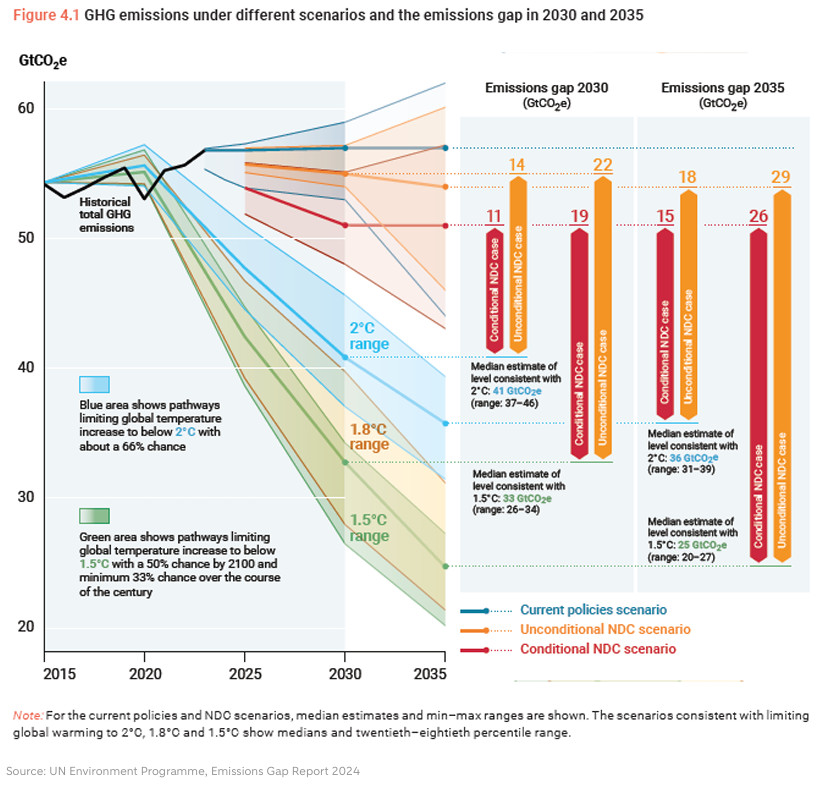
When evaluating current net-zero pledges, as at 1 September 2024, 101 parties representing 107 countries and covering approximately 82 per cent of global GHG emissions had adopted net-zero pledges either in law (28 parties), in a policy document such as an NDC or a long-term strategy (56 parties), or in an announcement by a high-level government official (17 parties). Since the previous Emissions Gap Report 2023, only Romania has added a net-zero target. An additional twelve parties covering an additional 2 per cent of global GHG emissions have another (non-net-zero) GHG mitigation target as part of their long-term strategy. As regards to timing, a total of 37 per cent of 2019 global GHG emissions are covered by net-zero targets for 2050 or earlier, while 45 per cent of global emissions are covered by net-zero pledges for years later than 2050. Five parties, representing only 0.1 per cent of global emissions, report they have already achieved net-zero emissions and have explicitly committed to maintaining this status.
… and drastically more ambitious plans are needed, particularly from G20 countries
The Paris Agreement states that countries have to submit new or updated NDCs to the UNFCCC every five years. The next round of NDC updates is due in early 2025 and will detail countries’ intended climate actions through 2035 (current end-point is 2030). According to Emissions Gap Report, current promises by countries based on conditional NDCs are on track for a best case global warming of 2.6°C. Therefore, COP29 needs to set the stage for drastically more ambitious NDCs to be announced at the beginning of 2025.
In order to keep the 1.5°C degrees target within reach, ambitious 2035 targets need to be set in combination with overachieving on the 2030 targets. Also, the amount of emissions falling under targets (currently 55%), needs to be increased. Finally, some relevant climate goals are not explicitly accounted for in NDCs according to the UNFCCC, for instance the transitioning away from fossil fuels.
Being responsible for three quarters of current global CO2 emissions the G20 countries will need to do the heavy lifting in GHG reduction. The gap between current policies and NDCs is assessed to be relatively small for the EU. However, 11 of the G20 are assessed to be falling short on their NDCs taking into account existing policies. There are different approaches to allocate the emission reduction goals among countries to reach a certain collective goal, such as that of the Paris Climate Accord. One of these approaches is that of the most cost-effective pathway: where and in which sector is emission reduction the cheapest? Another is some form of fair share approach. According to the UNFCCC report both approaches indicate that collectively the G20 would need to cut emissions faster than the global average. The table below shows the future emissions that would be consistent with limiting warming to 1.5°C with no or low overshoot, as well as limiting warming to 2°C with a 66 per cent chance.
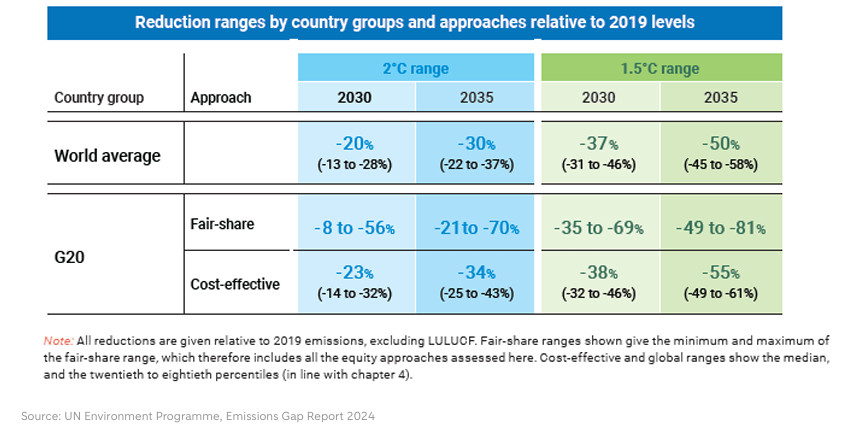
Swift action matters
Global GHG emissions fell during COVID-19 in 2020, but have subsequently continued to increase. This renewed rise and time lost in the path towards net-zero has several implications, the severity of which depends on what happens next. The Emissions Gap Report mentions that the CO2 emissions that have been added to the atmosphere since 2020 have further reduced the remaining carbon budget for limiting warming to below 2°C (>66 per cent chance) and around 1.5°C (>50 per cent chance) to 900 and 200 GtCO2, respectively. Assuming that the emissions gap is still bridged by 2030, between 20 and 35 Gt of additional cumulative CO2 emissions will be emitted over the period 2020–2030, compared with the mitigation scenarios consistent with limiting global warming to specific targets. This would result in warming of about 0.01 to 0.02°C higher than the original pathways indicate. A lack of deep methane reductions would also contribute to higher warming.
A consequence of the time lost since 2020 is that the deepest emission reductions become harder to achieve because of the continued lock-in of carbon-intensive infrastructure and less time left to realise the emission reductions required. This reduces the feasibility of bridging the gap by 2030. Indeed delays until 2023 have already raised the minimum level of global warming that must be anticipated. Each year of delay also compounds climate impacts, some of which are irreversible. To illustrate, the data underlying the emissions gap assessment indicate that, if stringent climate action starts in 2024, the annual emission reductions required to meet the levels in 2035 consistent with below 2°C and 1.5°C scenarios are 4 and 7.5 per cent per year on average, which is about 1.5 percentage points lower than the reduction rates to meet the emission levels in 2030. However, if countries only achieve the current unconditional NDC emission levels in 2030 and postpone stringent mitigation until then, the required cuts in emissions double to about 8 per cent per year from 2030 to 2035 for the below 2°C scenario and 15 per cent per year on average for the 1.5°C scenario.
New quantifiable goal for climate finance will need to be vastly more ambitious as well as more concrete
At the current COP29 countries are also due to agree a new climate finance goal. Climate finance refers to local, national or transnational financing, drawn from public, private and alternative sources of financing. The Kyoto Protocol and Paris Agreement call for financial assistance from parties with more financial resources (such as the EU and US) to those that are less endowed and more vulnerable. In 2009, developed countries have committed to mobilise USD 100bn of climate finance a year by 2020, a target that was meant to run through to 2025. The target was missed in 2020, and was only reached two years later, in 2022. By 2020, 80% of the USD100bn was from public sources, 20% was from private sources. In the Paris agreement it was decided that before 2025, a new collective target from a floor of USD 100bn per year would be set, which implies that negotiations will have to be round off at the COP29.
Negotiations about the new climate finance target probably will be tough. Some developing counties have demanded a tenfold increase in climate finance to around USD 1-2 trillion per year. Meanwhile developed countries have struggled for years to hit the relatively modest $100bn goal, implying that these new demands raise the issue of plausibility. According to independent research institute Carbon Brief major contributors including the UK, France and Sweden have all slashed their aid budgets in recent years, reducing the pool of public finance available. Meanwhile, the US has consistently underperformed in providing climate finance. This is despite most analyses indicating that it should be by far the largest contributor, as it is the world’s richest country and the biggest historic contributor to climate change. Following the Republican clean sweep in the US elections, the probability of the US contributing significantly has declined (also see below).
Furthermore, decisions need to made about expanding the number of countries that must provide climate finance. As it stands, only 23 countries are obliged to provide climate finance, including western Europe, the US, Japan, Australia, Canada and New Zealand. Global-north nations broadly want relatively wealthy, emerging economies, such as China and the Gulf states, to start contributing officially as well. Also according to certain criteria there are 50 non-contributor countries that tick a number of boxes that would make them potential new donors, with a handful of relatively wealthy or large nations scoring the highest. Finally, decisions need to be made about the type of finance, for instance grants or loans (about 69% currently is loans). Providing public-sector finance is key, because private-sector finance is less well suited for adaptation or for responding to loss and damage as investment returns are uncertain.
What does Trump’s win mean for global climate change?
President Trump withdrew the US from Paris Agreement in 2017. In President Biden’s term, in early 2021, the United States re-entered the Paris Agreement, consequently adhering to the global long term goal of keeping global warming to well below 2 degrees. Not long after, in April, by announcing its Nationally Defined Contribution (NDC) of reducing emissions to a level 50-52% below 2005 levels by 2030, or reaching an absolute level of 4,790 MtCO2E by 2030, the country joined the United Nations Framework Convention on Climate Change (UNFCCC) in their green transition. Mr Trump’s recent victory in the US elections means that the US will likely withdraw from the Paris Agreement for a second time. So where does the US currently stand in terms of climate policy and how might that change under President Trump?
To achieve the targets set out in 2021, the US authorities have focused on developing subsidy schemes which encourage investment in the transition. In 2021, congress passed the Bipartisan Infrastructure Law (BIL) and the CHIPS and Science Act. While the first provides USD 550bn investment in infrastructure and in major technological progress to the power grid, the second focuses on the STEM workforce and R&D, raising the bar of technological innovation with a USD 280bn stimulus injection. However, the main tool used by the Biden administration has been the Inflation Reduction Act (IRA), passed in 2022. The IRA provides nearly USD 400bn by 2030 in federal funding toward clean energy, with the goal of meeting the country’s NDC. USD 250bn of the total amount will be invested in energy, around 50bn in manufacturing while almost 70bn will be utilised for the environment and the adoption of electric vehicles. The funds are distributed through a mix of tax incentives, grants and loan guarantees. The United States’ latest effort is the ‘EPA Standards for the Power and Transport Sector‘, which came into effect in 2024, providing a further stimulus to the country’s decarbonizing efforts. Combined, these investment packages amount to over USD 2500bn.
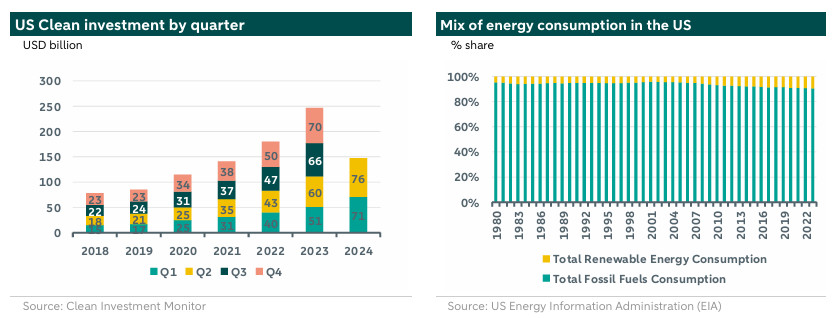
Despite the Biden administration’s efforts, according to Climate Action Thermometer (CAT), the policies set out by the outgoing president might not be enough to meet its national and global climate targets. At the current emission-reduction pace, the country will fall short of its 50-52% reduction goal, stopping at an estimated range 29-39% from 2005 levels in 2030. Emissions are forecast to decline at an average of 1.7% to 3.9% per year and reach 4.6–5.4 GtCO2e/year by 2030. Under these projections, the US would achieve 64%–87% of its emissions reductions target by 2030, indicating a gap of 13%–36% that would need to be filled with new and additional climate policies. For this reason, Biden’s policies, despite being considered a substantial effort, are qualified as being ‘insufficient’.
According to analysis by Carbon Brief , the Donald Trump victory could lead to an additional 4bn tonnes of CO2 emissions, or a 28% reduction of emissions compared to 2005 levels by 2030, compared to Biden’s NDC of 50-52%. This additional amount of CO2 almost equates to Europe and Japan’s combined yearly emissions. To measure the impact of the next Trump term on climate, Carbon Brief relied on 6 different models, where all assume a Trump strict climate policy. This translates to exiting the Paris Agreement once again as well as totally or partly halting the IRA. Models also assume a pick-up in fossil fuel production and consumption under a new Trump term. Although there is much uncertainty about whether the incoming president will execute the moves announced in the election campaign, the key question is about the resilience of the current policies. Based on reports in the press including interviews with US investors, policy makers and consultants we have made an overview of the Biden administration’s climate policy measures that could easily be abolished (‘vulnerable’) and the measures that are more likely to stick (‘resilient’) (see table below).
While tax credits and funding in the IRA has been designed to withstand in time, the bill presents other weaknesses. The government is expediting efforts to roll out investments (USD 60bn have been assigned as of 30 September 2024 out of a pool of USD 80bn due to climate funding), however, the other policies in the IRA such as methane-crackdown, the rollout of EVs, curbs on power plant pollution and the scaling of off-shore wind projects face the risk of simply being lifted or halted by the next Trump administration.
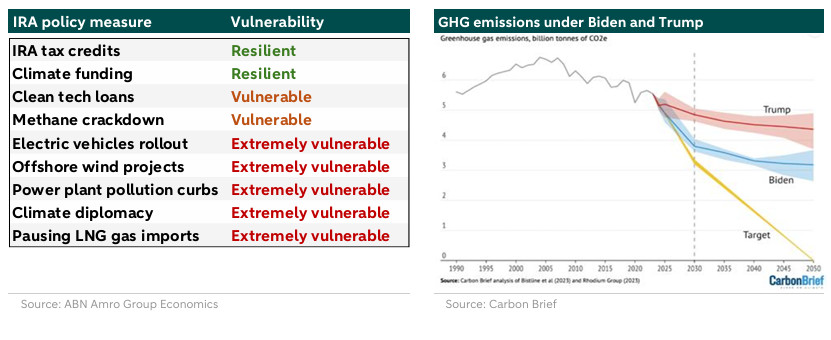
While the Biden administration's efforts might have fallen short of achieving the NDC as well as the global 2050 goal, a Trump presidency could not only jeopardize the attainment of these targets but also complicate international climate diplomacy given the world's second-largest emitter would no longer be showing leadership on the issue.
